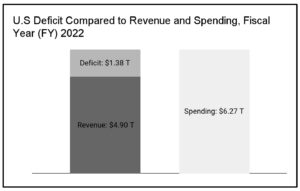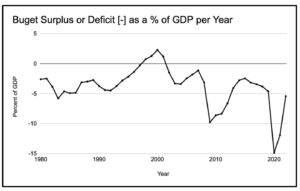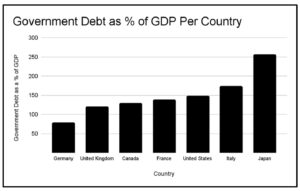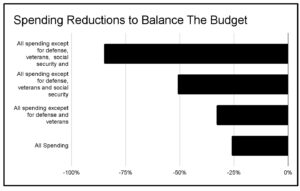If one billion dollars is equal to a school bus filled to the brim with $100 bills, the United States’ annual budget is equal to about 6,300 school buses. These funds pay for everything from keeping parks open and building new highways to unemployment benefits, the President’s salary, and the military’s tanks, planes, ships, and soldiers. At the same time, the United States has a budget deficit, meaning that more than a thousand of those school buses are filled with money that the government borrows to pay its bills. Where did this budget deficit come from? Does it matter? What needs to happen to reduce it?
What is a balanced budget?
A balanced federal budget exists when the government collects as much in taxes and other revenues as it spends on government programs. These programs can be divided into two groups: First, mandatory spending, or funds spent on so-called entitlement programs, where the government provides benefits to anyone who qualifies for them. Social Security and Medicare are the two largest entitlements, and about 60 percent of the current federal budget is spent on entitlements. The second group is discretionary spending, programs where Congress and the President decide each year how much to spend. Discretionary programs include spending on the military and all other domestic programs.
How big is the federal budget deficit?
The figure below shows that in fiscal year 2022 (October 1, 2021 – September 30, 2022), the US government spent $6.27 trillion, but collected $4.90 trillion in revenue, leading to a budget deficit of $1.38 trillion. Economists usually measure the deficit in terms of the size of the US economy, which is measured by the Gross Domestic Product (GDP). Using this measure, the federal deficit in 2022 was 5.4% of GDP.
Over the last three decades, the federal government has usually run a budget deficit. The figure below shows annual budget deficits and surpluses measured as a percentage of GDP. The only time the US government has run a surplus was in the late 1990s and early 2000s. Budget deficits have been especially large in recent years, which could have major economic implications. While COVID-19’s impact on the budget deficit is predicted to be temporary, pre-COVID deficits were still higher than in previous years.
Why Is There a deficit?
The current budget deficit has its roots in two events. First, business closures and unemployment from the COVID-19 pandemic led to a significant reduction in tax revenue. At the same time, the federal government spent over six trillion dollars to combat the pandemic, develop and distribute vaccines, and assist businesses and individuals. The combination of lower revenues and higher expenses led to the highest budget deficits ever recorded, some 3.1 trillion dollars in 2020 and 2.4 trillion in 2021.
The second explanation for current deficits is the combination of tax cuts and program changes enacted in recent years by Congress and the President. Tax cuts (including lower taxes on wealthy individuals and on corporations) enacted in 2017 reduced government revenue by about $1.3 trillion dollars over ten years. More recently, Congress approved over $550 billion dollars for infrastructure projects, $280 billion for technology projects and research, and $738 billion dollars on a proposal that would fund clean energy and greenhouse gas reduction projects and extend health care subsidies. The latter proposal also included about $281 billion in spending reductions from efforts to lower the prices the government pays for spending on prescription drugs for Medicare recipients and $530 billion from tax increases and increased enforcement of existing tax laws.
Do Other countries or American states have balanced budgets?
Most developed nations have annual budget deficits. The figure below shows the size of the national debt (accumulated budget deficits) for the seven nations in the G7, a group of the world’s largest, most-developed nations. For each country, the debt is measured as a percentage of GDP. The US has the third-largest deficit, at 148% of annual GDP.
Almost all American states have Balanced Budget Requirements (BBR), including a prohibition on carrying debt into the next fiscal year, requiring that the governor sign a balanced budget, or requiring that deficits be made up by a surplus in the next fiscal year. Only two states, Wyoming and North Dakota, have no BBR. While BBRs ensure that states do not initiate programs without deciding how to pay for them, they also constrain states from responding effectively to crises such as the COVID pandemic.
Do budget deficits matter?
Most economists believe that small or temporary federal deficits have little or no impact on economic conditions such as growth, unemployment, and inflation. However, problems may arise if the national debt (accumulated deficits) becomes too large.
Because budget deficits are funded by selling government bonds, a rising debt draws away some funds that might otherwise be used for productive capital investments. When the government borrows from the public to finance spending, the funds come from the national pool of savings, which increases interest rates due to a lower supply of funds: this “crowds out” private investment, as investors must compete with government borrowing for the same pool of national saving.
Increased debt also requires some government revenue to be used for interest payments, reducing the amount of funds available for other needs, particularly unexpected problems. Currently, the US pays more in debt payments than it does for veterans’ benefits, education, disaster relief, agriculture, science and space programs, foreign aid, natural resources, and environmental protection combined.
Increased government borrowing can lead to higher interest rates, making it harder for firms to borrow money for new initiatives and increasing the cost of mortgages and car loans. Higher interest rates can also reduce exports as well as economic growth.
However, in times of economic downturn, such as during the COVID-19 pandemic, deficits can actually be beneficial, as government spending can stimulate demand and boost economic growth.
What changes are needed to balance the federal budget?
To have a balanced budget, the amount of money the federal government collects in taxes and other revenue must equal the amount of money spent on programs and services. This change can happen by increasing taxes, reducing spending, or some combination.
For spending cuts, the most important question is to decide whether some programs should be exempt from deficit-reduction efforts. Should Social Security and Medicare be excluded? What about defense spending? Depending on how you answer these questions, the size of the cuts needed to balance the budget is very different, as shown in the figure below.
The figure shows that if no programs are exempt, spending would have to be reduced by about 25% to balance the budget in ten years. (A portion of federal revenue would be needed to pay interest on existing debt.) If defense and veterans programs are excluded, 305 cuts are required. And in defense and veterans programs are excluded as well as Social Security and Medicare, the remaining programs would need to be cut about 85% to achieve balance.
On the taxation side, repealing the 2017 Trump tax cuts would generate almost $2 trillion dollars over ten years, about a third of the amount needed to bring the budget into balance. (For more details, or to make other choices about program cuts and tax increases, see the Debt Fixer Simulation in the Further Reading section of this brief.)
Would a constitutional balanced budget amendment be effective?
Another solution is to pass a constitutional amendment requiring a balanced federal budget. This is essentially the federal version of a balanced budget requirement (BBR). Because politicians face pressure from their constituents and interest groups, a BBR would enforce fiscal discipline during the budget-writing process. The biggest advantage of a balanced budget amendment is that it would limit spending and reduce the accumulation of debt.
One disadvantage to a constitutional requirement is that it makes the government less responsive to unpredicted emergencies like natural disasters or wars. Additionally, if faced with a recession or economic downfall, the government would be barred from spending that would otherwise stimulate the economy. Macroeconomists predict that the effect on the economy would be disastrous and would inhibit economic recovery. Running budget surpluses would also be prohibited under a constitutional balanced budget amendment.
In order to adhere to a BBR but also address a recession or emergency situation, the government would either have to cut mandatory spending or raise taxes. Cutting mandatory spending would most likely involve a reduction in benefits and stimulus programs, such as Social Security and Medicaid, because these are the nation’s largest expenditures. In this way, establishing a BBR would come at the expense of the American people due to increased tax burdens and a reduction in benefits.
One proposal to combat this problem is to automatically waive the requirement during times of national crisis like a recession or war. Most proponents of the amendment also allow the BBR to be waived if there is at least 60% support in both the House and the Senate. However, by allowing the BBR to be surpassed, the efficacy of the constitutional amendment would be called into question. If legislators can suspend the requirement, then it can lead to the original problem of a continuous deficit and an increase in the national debt.
Further Reading
Congressional Budget Office. (2020). Options for reducing the deficit: 2021 to 2030. Accessed 2/10/23, available at https://www.cbo.gov/publication/56783
Committee for a Responsible Federal Budget. (2023). Debt Fixer. www.crfb.org/debtfixer, accessed 4/15/23.
Weinstock , L. R. (2021). Federal deficits, growing debt, and the economy in the wake of COVID-19. Congressional Research Service. accessed 2/10/23, available at https://crsreports.congress.gov/product/pdf/R/R46729
Sources
What Is a Balanced Budget?
Congressional Budget Office. 2020. Options for reducing the deficit: 2021 to 2030. Accessed 2/10/23, available at https://www.cbo.gov/publication/56783
US Treasury Fiscal Data. 2023. What is the National Deficit? Data Transparency, accessed 2/10/23, available at https://tinyurl.com/5eh2ndnn
How Big Is the Federal Budget Deficit?
Bureau of Economic Analysis. 2023. Gross Domestic Product, Fourth Quarter and Year 2022. Available at https://tinyurl.com/4xy9ffks
DeSilver, D. 2023. 5 facts about the U.S. National Debt. Pew Research Center. Accessed 2/24/23, available at https://tinyurl.com/2wzp7338
US Treasury Fiscal Data. 2023. What is the National Deficit? Data Transparency, accessed 2/10/23, available at https://tinyurl.com/5eh2ndnn
Auerbach, Alan J & Gale, William G. 2022. The COVID Pandemic and the Federal Budget. Brookings, accessed 3/23/23, available at https://tinyurl.com/yc829bb8
Auerbach, A. J., & Gale, W. (2020). The effects of the COVID pandemic on the federal budget outlook. Business economics (Cleveland, Ohio), 55(4), 202–212. https://doi.org/10.1057/s11369-020-00188-y
Why Is There A Deficit Now?
Rogers, D. 2018. POLITICO Analysis: At 2.3 trillion cost, Trump Tax Cuts Leave Big Gap. Politico, accessed3/16/23, available at https://tinyurl.com/cd8s5fz2
103rd Congress. 1993. Omnibus Budget Reconciliation Act of 1993, H.R.2264. Available at https://tinyurl.com/5n7zsy9m
Weinstock , L. R. (2021). Federal deficits, growing debt, and the economy in the wake of COVID-19. Congressional Research Service. accessed 2/10/23, available at https://crsreports.congress.gov/product/pdf/R/R46729
Ganong, P., Greig, F., Noel, P., Sullivan, D. M., & Vavra, J. (2022). Lessons learned from expanded unemployment insurance during COVID-19. Brookings, accessed 2/24/23, available at https://tinyurl.com/47nd8bj3
Kellie Moss. 2022. The coronavirus aid, relief, and Economic Security Act: Summary of key health provisions. KFF. Accessed 2/24/23, available at https://tinyurl.com/bddnwup8
Aussenberg, R. A., Billings, K. C., & Falk, G. (2023). USDA Nutrition Assistance Programs: Response to the COVID-19 Pandemic. Congressional Research Service, accessed 3/6/23, available at https://crsreports.congress.gov/product/pdf/R/R46681
USAspending.gov. 2023. COVID-19 Spending. Accessed 3/6/23, available at https://tinyurl.com/27vt5ehj
Do Other Countries or American States Have Balanced Budgets?
OECD. (2021). General Government Debt. Accessed 2/24/23, available at https://tinyurl.com/4rpbrauk
Reuben, K., & Randall, M. 2017. Balanced budget requirements. The Urban Institute, accessed 2/10/23, available at https://tinyurl.com/9bzfhrxj
Tax Policy Center. (n.d.). What are state balanced budget requirements and how do they work? Tax Policy Center, accessed 2/24/23, available at https://tinyurl.com/3a2wmp8c
Do Budget Deficits Matter?
Labonte, M. (2008). Do Budget Deficits Push Up Interest Rates and Is This the Relevant Question? Congressional Research Service, accessed 3/23/23, available at https://crsreports.congress.gov/product/pdf/RL/RL31775/6
Peletier, B. D., Robert A. J. Dur, & Swank, O. H. (1999). Voting on the Budget Deficit: Comment. The American Economic Review, 89(5), 1377–1381. http://www.jstor.org/stable/117065
Elmendorf, D. W. (2011). Four observations about the federal budget. Business Economics, 46(3), 139–143. https://doi.org/10.1057/be.2011.19
Doyle, R., & McCaffery, J. (1991). The Budget Enforcement Act of 1990: The path to no fault budgeting. Public Budgeting Finance, 11(1), 25–40. https://doi.org/10.1111/1540-5850.00892
What Kinds of Changes Are Needed To Balance The Federal Budget?
Rivlin, A. M. & Sawhill, I. V. 2019. How to balance the budget. Brookings, accessed 2/10/23, available at https://tinyurl.com/mva3y79u
Rogers, D. L. 2007. Reducing the Deficit Through Better Tax Policy. Brookings Institute, accessed 2/24/23, available at https://tinyurl.com/2p32za5c
Alesina, A., Giavazzi, F., & Favero, C. A. 2018. Improving economic growth: Cut spending or raise taxes? IMF, accessed 2/10/23, available at https://tinyurl.com/4pcbhx38
Schick, A. 2016. A surplus, if we can keep it: How the Federal Budget Surplus Happened. Brookings, accessed 3/6/23, available at https://tinyurl.com/2p8r9ay2
Congressional Budget Office. 2020. Options for reducing the deficit: 2021 to 2030. Accessed 2/10/23, available at https://www.cbo.gov/publication/56783
Would A Constitutional Balanced Budget Amendment Be Effective?
Asatryan, Z., Castellón, C., & Stratmann, T. (2018). Balanced budget rules and fiscal outcomes: Evidence from historical constitutions. Journal of Public Economics, 167, 105-119. Available at https://doi.org/10.1016/j.jpubeco.2018.09.001
Azzimonti, M., Battaglini, M., & Coate, S. (2016). The costs and benefits of balanced budget rules: Lessons from a political economy model of fiscal policy. Journal of Public Economics, 136, 45-61. https://doi.org/10.1016/j.jpubeco.2016.03.001
Schick, A. 1997. Hearing on the Proposed Balanced Budget Amendment to the Constitution. Brookings, accessed 3/25/23, available at https://tinyurl.com/2mva5xnv
Charts
U.S. Office of Management and Budget & Federal Reserve Bank of St. Louis. 2023. Federal Surplus or Deficit as Percent of Gross Domestic Product. FRED, available at https://tinyurl.com/2p8a4ajw
US Treasury Fiscal Data. 2023. What is the National Deficit? Data Transparency, accessed 2/10/23, available at https://tinyurl.com/5eh2ndnn
OECD. (2023). General Government Debt. OECD iLibrary, accessed 2/24/23, available at https://doi.org/10.1787/cc9669ed-en
Tax Policy Center. 2020. What are state balanced budget requirements and how do they work? Urban Institute, Brookings Institution, and individual authors, accessed 3/25/23, available at https://tinyurl.com/3a2wmp8c
Committee for a Responsible Federal Budget. (2023). What would it take to balance the budget? Accessed 3/25/23, available at https://tinyurl.com/35pdn8h6
This policy brief was researched and written in February – April 2023 by Policy vs. Politics interns Sarah Hanna, Jordyn Ives, and Aditi Menon, and revised by Dr. William Bianco, Research Director for Policy vs. Politics.





